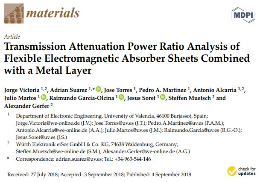
Catedra Würth EMC has published a Research Article related to characterize the ability of Flexible Absorber Sheets (FAS) to reduce conducted electromagnetic noise. The article is titled "Transmission Attenuation Power Ratio Analysis of Flexible Electromagnetic Absorber Sheets Combined with a Metal Layer" and it has been published in Materials, a journal indexed by the Journal Citation Reports (JCR).
This publication reflects the work carried out in recent months both Professors and Researchers of the University of Valencia and Engineers of the company Würth Elektronik. Thereby, one of the main Catedra foundation, the Research, has been put into practice because from the University and Würth Elektronik intend to support the characterization and study of new solutions based on filtering electromagnetic noise.
This article is focused on charactering a novel structure that is based on an absorber film with a metal layer attached on its top side. Two different absorber compositions were combined with Al and Cu metal layers in order to study the improvement on the performance of these structures, depending on the complex permeability, absorber film thickness, and type of metal. The transmission attenuation power ratio of the absorber films is analyzed and compared to the performance of absorber and metal structures by following the IEC standard (IEC 62333-2). Likewise, the re-radiation parameter has been analyzed with the aim of ensuring that the presence of a metal layer on the absorber material does not lead to induce a parasitic magnetic flux.
The results obtained show that the use of a metal layer provides a higher shielding effectiveness when it is attached to those sheets with low thickness. Accordingly, with this last point, the use of FAS and metal structure makes it possible to save space at the same time that provides high absorption loss without resorting to high-thickness absorber sheets.
Because of the Materials Journal is Open Access, the complete article can be consulted through the next link.








